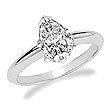Round
Oval
Princess
Emerald
Heart
Asscher
Cushion
Pear
Marquise
All photos and rings can be found here.
All of the above diamonds have been shown in solitaire form (meaning one, single diamond). Of course there are multiple settings that you can choose from (diamond bands, multi-stone, etc).
What about the 4 "Cs"?
What are they?
All of the above diamonds have been shown in solitaire form (meaning one, single diamond). Of course there are multiple settings that you can choose from (diamond bands, multi-stone, etc).
What about the 4 "Cs"?
What are they?
Cut
The "brilliance" of a diamond depends on it's cut.
Diamonds may receive a cut, from most to least desirable:
- Ideal
- Premium
- Very good
Diamonds may receive a cut, from most to least desirable:
- Ideal
- Premium
- Very good
- Good
- Fair
- Poor
Clarity
Clarity refers to the size, number, and visibility of inclusions, or flaws, that a diamond has. Clarity is explained through a system F (flawless) through I (included).
F - Flawless
No internal or external flaws; these diamonds are rare and expensive.
IF - Internally flawless
No internal flaws, but some external flaws; still rare.
VVS1-VVS2 - Very, very slightly included (two grades)
Extremely minor inclusions that are still very difficult to detect, even when magnified under 10x.
VS1-VS2 - Very slightly included (two grades)
Minor inclusions, still difficult to detect, even when magnified under 10x.
SI1-SI2 - Slightly included (two grades)
Minor inclusions detected easier when magnified under 10x; still cannot detect with the naked eye.
I1-I2-I3 - Included (three grades)
Inclusions easily detected when magnified under 10x and to the naked eye. Diamonds of this quality are not recommended.
No internal or external flaws; these diamonds are rare and expensive.
IF - Internally flawless
No internal flaws, but some external flaws; still rare.
VVS1-VVS2 - Very, very slightly included (two grades)
Extremely minor inclusions that are still very difficult to detect, even when magnified under 10x.
VS1-VS2 - Very slightly included (two grades)
Minor inclusions, still difficult to detect, even when magnified under 10x.
SI1-SI2 - Slightly included (two grades)
Minor inclusions detected easier when magnified under 10x; still cannot detect with the naked eye.
I1-I2-I3 - Included (three grades)
Inclusions easily detected when magnified under 10x and to the naked eye. Diamonds of this quality are not recommended.
Colour
Lighter diamonds allow for more light to hit the diamond, and thus, they create a better sparkle. Colour is grades using the letters D through Z.
D, E, F
Colourless
G, H, I
Near colourless
Colourless
G, H, I
Near colourless
J, K, L, M
Faint yellow
Faint yellow
After this, they become "very light yellow" to "yellow" and even "brownish." While D, E, F are most desirable, it is notable that G, H, I grade diamonds also appear virtually colourless to an untrained eye.
Carat weight
Diamonds are measured by a unit of weight: carats. The higher the carat, the larger the diamond. Larger diamonds are more rare to find in nature than small diamonds, thus, they are more expensive.
- What was or will be more important to you of the 4 C's? What is your favourite diamond shape?










No comments:
Post a Comment